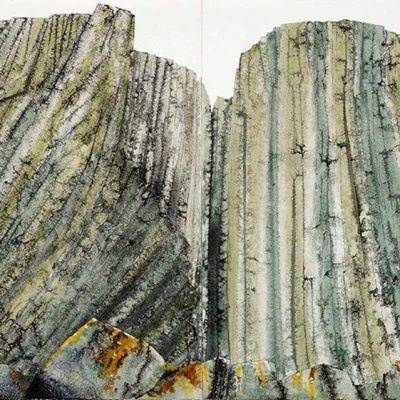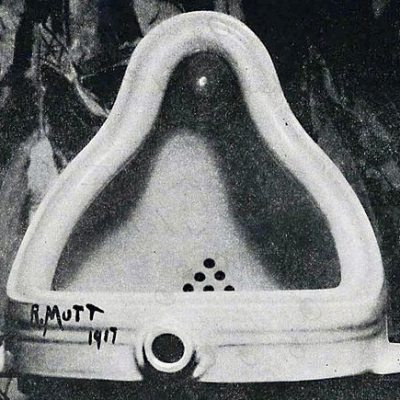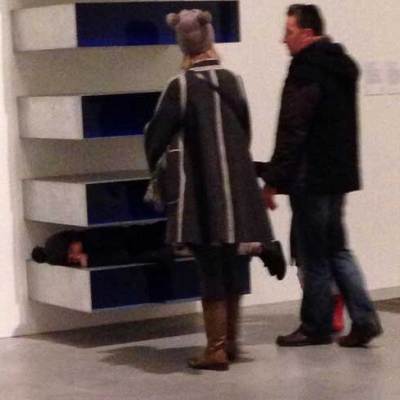At The Queen’s House, Greenwich, on a grim and grey Valentine’s Day, visitors are greeted by a healthy dose of romantic drama. Separated by the breadth of Inigo Jones’s celebrated cubed hall, figures representing Admiral Lord Nelson and his wife Fanny stare frostily across the void (or would stare, were it not for the fact that like so many of Yinka Shonibare’s figures, they are headless).
Fanny’s Dress (2011), Yinka Shonibare Courtesy of the artist and James Cohan Gallery, New York/Shanghai, with ‘Portrait of Frances Nelson’, (c. 1800), British School. Photo: © National Maritime Museum, Greenwich, London

In their respective rooms, they are surrounded by works of art exploring their story: Fanny by Romney’s beautiful renderings of her husband’s mistress and great love Emma Hamilton, and Nelson by Samuel Drummond’s series of episodes from his life, redeploying a litany of art historical types (descent from the cross, apotheosis, death of the Virgin) to add extra gravitas and awe to these depictions of the nation’s maritime hero.
Shonibare’s Fake Death Pictures (2011) similarly borrow from art-historical precedents (from Henry Wallis’s Death of Chatterton to François-Guillame Ménageot’s Death of Leonardo da Vinci in the Arms of Francis I) to provide Nelson with an alternative series of endings. They provide a telling counterpoint to the earlier constructed images, tipping their drama towards melodrama and encouraging us to think carefully about how they work. It is the pitfalls and potentials of these kinds of interventions that the ‘Culture Clash? Contemporary arts in historic contexts’ conference (the reason for my romantic rendezvous with Nelson and Shonibare) set out to explore.
Nelson’s Jacket (2011), Yinka Shonibare Courtesy of the artist and James Cohan Gallery, New York/Shanghai, with ‘The Death of Nelson’ (c. 1806) by Samuel Drummond. Photo: © National Maritime Museum, Greenwich, London

‘Culture Clash’ was in some ways an exercise in self reflection for Royal Museums Greenwich. Between 1999 and 2009, somewhat sporadically, their New Visions programme introduced such artists as Tacita Dean and, memorably, Conrad Shawcross, into various spaces across the museums. An astute analysis of the different phases of this programme highlighted not only the different approaches of the curators who led the initiative, but also the fact that even within one institution, contemporary art programmes might work in very different ways, from true interventions (with contemporary pieces interspersed with the collection for visitors to happen upon) to contemporary exhibitions existing in their own white cube space within, but separate from, the museum.
There was a tone of healthy scepticism (but not cynicism) among the speakers, many of whom are directly involved in delivering these projects (at Greenwich, the V&A, the Natural History Museum, the Bronte Parsonage, Dommuseum Salzburg). These are people who are grappling with such ways of working, interested in the potential to bring compelling new ways of experiencing collections and historic spaces but aware that, without (and indeed even with) careful consideration, such interventions can fall well short of the mark.
Fake Death Picture (The Death of Chatterton- Henry Wallis) (2011), Yinka Shonibare Courtesy of the artist and James Cohan Gallery, New York/Shanghai, with ‘The Apotheosis of Nelson’ (c. 1805-18) by Scott Pierre Nicolas Legrand, and ‘The Death of Lord Nelson in the Cockpit of the Ship ‘Victory” by Benjamin West. Photo: © National Maritime Museum, Greenwich, London

A refreshing air of pragmatism also prevailed. We heard about the logistics of transporting a large contemporary artwork through the corridors of the V&A, and the fact that its location owed as much to the impossibility of siting such a heavy object on the historic mosaics in the sculpture gallery as any more aesthetic curatorial concern.
There was an honesty around the impact of the need to prioritise private hire of spaces for events – that in the current financial climate, the level of disruption caused to the needs of corporate hirers might be a more compelling concern than the level of disruption to the accepted hierarchies of the museum. We also touched on the intersection between museum, artist, collector and market place that these interventions shine a light on; the impact of displaying contemporary work held in a private collection at Versailles on that work’s market value, for example, and the legal and ethical implications of this.
The question of contemporary art in historic settings is hardly a new one (indeed several of the speakers looked back at its lineage from Andy Warhol’s Raid the Icebox of 1969 through institutional critique from the likes of of Hans Haacke, Daniel Buren, Andrea Fraser and Fred Wilson to the more recent vogue in major museums), but ‘Culture Clash’ succeeded in throwing some new light on particular aspects of this multi-faceted phenomenon – much as the best contemporary interventions themselves reinvigorate our experience of the historic contexts they occupy.
Related Articles
Private Views: ‘Going Public: Challenges and Perspectives in the Display of Private Collections’ Symposium at the Courtauld Institute (Katy Barrett)



